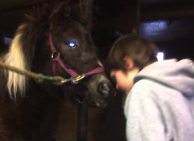 “I’m just an animal lover so I could never do that,” the lady at the library told me. In fact, she’s not the only one who has said this to me when the conversation about my line of work inevitably turns to the death of animals. I grit my teeth because I know they don’t know how what they just said cuts me like a knife. They’re implying that because, once a quarter, I can load up a couple of cows and several pigs and bring them to the processor or even dispense with a chicken myself, that I am made of stone. That I can just toss animals aside and don’t give their death a second though. In fact, I probably give more thought to their LIFE as well as their death than anyone I’ve ever had this conversation with. Death is definitely the hardest part of life on a farm. It beats out shoveling manure, heavy lifting and hours and hours of fence work. I’ve never spent a sleepless night worrying about how I’m going to lift those 50 lb bags of grain the next day, but I have spent many worrying about a horse recovering from colic, a pig with scours, an anemic goat. I’ve sacrificed my own night’s sleep nursing these animals back to good health, or sadly, sometimes keeping them company and making sure they are warm in their final hours. I don’t, however, mourn or worry about animals we send to the processor. I celebrate them. I give them a final pet on the neck and thank them for providing us with entertainment in life and nourishment in death. Each time our family eats meat, we are thankful for the lives of the animals that provided that meat to us. Because we are so acutely aware that meat=animals, we are careful to eat less of it and make the most out of each pound. If you love animals more than I do, I’d encourage you to do the same.  I spend a lot of time thinking about what our family eats. We raise our own meat, we have a veggie share from a local farm during the local growing season and I preserve whatever we don’t eat. We even grow a tomato garden and can our own tomatoes for winter. I read the back of almost every package we buy in the grocery store (though we try to avoid packages if at all possible). I put a lot of effort in to this and my children understand why. It’s conversation for us in the grocery store and at the dinner table. We value putting high quality ingredients into our body. So this is why I have such a hard time when other (well intentioned) people give my beautiful boys candy. It’s a treat for helping around the farm, a treat for getting together at a cub scout event, from friends for their birthday, from their teacher because they did well in school (!?), from their friends on Valentine’s Day and Halloween. “Treats,” people say. “It’s only one day,” people say. Here’s my perspective: These “treats” contain sugar, artificial colors and artificial flavors that I believe (from the research I’ve done) are VERY BAD for my kids’ bodies. So I actually don’t consider most candy “treats” and I don’t call them that in our house. But I don’t like to say no to my kids. It’s hard to take candy out of their mouths. Please don’t make me have to do this. Please value my kids as much as I do and don’t feed them junk food with poison in it. And I promise not to feed yours these low quality ingredients. I’ll show my love and appreciation for kids with hugs and kind words than toxic chemicals any day. I mean, look at these guys. I only want the best for them.  I participated in the viral 30 Days of Thanks that people were doing on Facebook. I liked the inspiration of seeing what my friends were thankful for and the challenge to find something every single day in my own life to be thankful. Of course we are all thankful for our families and our health, but the 30 days let us get a little silly. “I’m thankful for owning a vineyard….for the obvious reasons,” one friend wrote. Or even my own “I’m thankful for pony noses” while I was spending some time in the barn. We also were serious: “I’m thankful for the power of prayer.” “I’m thankful for the right to vote.” “I’m thankful for all who serve.” It was when I wrote my own “I’m thankful for my husband who goes to work EARLY in the morning so we can have good health insurance,” that I realized we were maybe missing the boat a bit on the thankfulness. I realized, after I posted, that I hadn’t actually said those words to HIM. In fact, I should say it every day. I’m hoping that our 30 Days of Thanks has put us in a habit of thinking about what we are thankful for every day, and now let’s go out and be ACTUALLY thankful instead of VIRTUALLY thankful. Tell people every day: your family, your friends, strangers. Do something nice to show your thanks. And that will put us all in the holiday spirit more than any shopping trip or holiday party ever could. Yesterday, Californians voted no to getting more information about their food. The question on their ballot asked if citizens of California wanted food companies to label Genetically Modified Foods. And they voted no. Some people think GMO are good for the environment (they can reduce herbicides and pesticide usage) and good for our growing world (they can feed more people globally). I think they’re crazy. I’ve read about their studies and understand what they are trying to accomplish, but sometimes you just have to go with your gut. The bottom line is: I don’t want to feed my family or myself GMOs. Easy, right? Not so much. What foods are genetically modified, or have GMOs in them? If you turn the package of ketchup over (with 4 boys, we go through lots of this stuff), the label doesn’t read “Genetically Modified High Fructose Corn Syrup” as the second ingredient. But I know that about 45 percent of corn grown in the US is genetically modified (as well as about 85 percent of soy). So is it, or isn’t it? For now, we won’t know – even in California. Their reluctance for labeling should give us some clue they have something to hide, but instead of relying on (or legislating) food companies to come clean with this information, I have another solution. Don’t buy packages; buy ingredients. For now, there are no genetically modified fruits and vegetables and if you stick to animals that were raised on pasture, you can avoid meat that was fed GMOs. If we can stay away from corn, soy, and canola (we are also producing GMO cotton in this country but I don’t think anyone is eating it), we can avoid almost all GMOs. If we vote with our dollars to say NO to GMOs, food companies will respond by not using them. Then biotech companies will respond with not making them. It’s important for our own health, the health of the animals we eat and the land on which our food grows. So I'm disappointed, California, but I'll continue on with my own strategy to defeat GMOs myself.
I was a Democrat in my 20s, a Republican in my 30s. Now that I’ve hit 40, I’ve almost fallen over the Libertarian cliff. I think becoming a farmer had something to do with it. I just really don’t want government to tell me what to do. Part of me loves the idea of a tax on sugary beverages and Mayor Bloomberg’s ban on Super-Sized-Sodas. I agree that these sugar filled beverages, among other processed food, are at the core of the obesity epidemic that is leading to millions of dollars in unnecessary healthcare and federal tax dollar spending. I’m just not sure I want government to tell people not to drink soda. Especially because there’s a better way to limit people’s consumption of sugary beverages: and that is to eliminate farm subsidies and incentivize smaller family farms around the country that can make fresh food available to all people. The invention of high fructose corn syrup (HFC) brought with it the downfall of American eating habits. All of a sudden, it became very easy to make EVERYTHING sweet. In nature, sweet is a luxury saved for perfectly ripe berries in the spring and fruits in the summer. Most natural sweet comes in mild forms: sweet corn, sugar pumpkins, sugar snap peas. Even maple syrup doesn’t come to us from nature in its highly concentrated form. We don’t get this huge blast of sweet from anything in nature the way we do from HFC. And that huge blast is what gets our bodies hooked. We are wired to indulge in sweet because it IS so rare in nature. Our problem is not that we don’t have enough food – Big Ag is pumping out more food off of less land than it ever has in history thanks in part to Genetically Modified Organisms (GMOs) and feed-lot-raised animals. But fresh food is not in the right places. The only bummer about fresh food (food that is grown, not packaged) is that is has a very short shelf life. This means people need access to it often (compare the shelf life of a peach to a Twinkie). In reality, Americans want their right to choose, and not have our food chosen for us. But subsidizing big Ag ventures such as commodity corn and soybeans, the government is choosing processed foods for its citizens, especially those located in so-called “food deserts”. So take yer hands off my Big Gulp Mr. Mayor, but tell your colleagues in Washington to stop bowing to the status quo and start helping out rural, neighborhood, and inner-city farms. |
AuthorA blog about farming and food. Kate Bogli owns and operates Maple View Farm, raising livestock and growing veggies, with her husband Jason. The farm has been in his family for 65 years. Archives
October 2021
Categories
All
|
 RSS Feed
RSS Feed